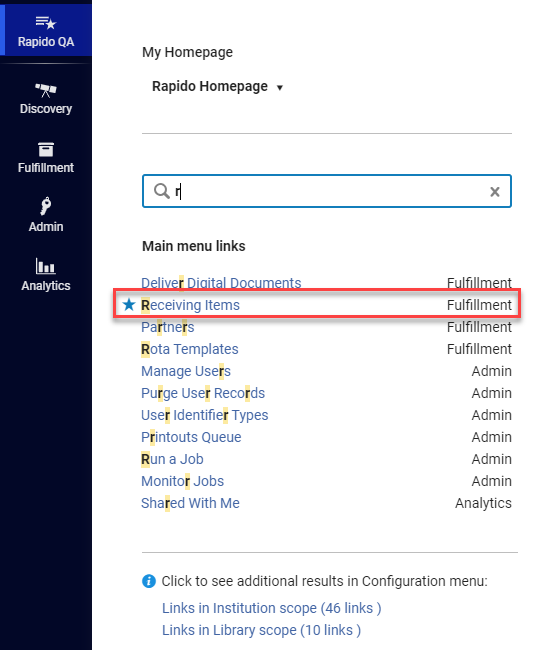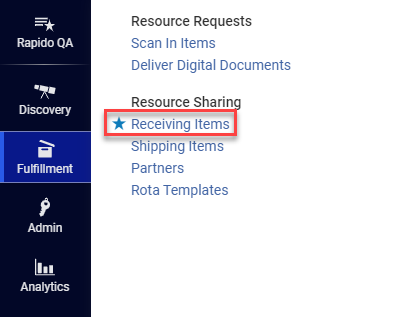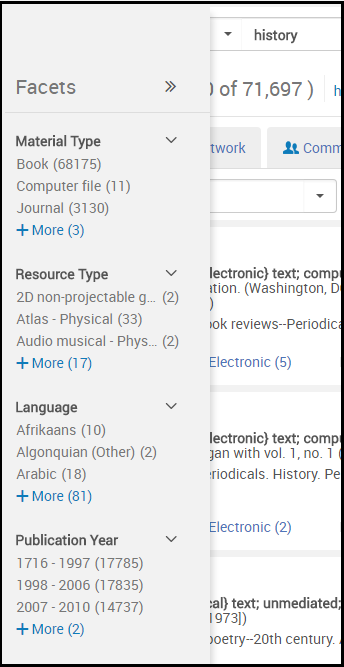The Rapido User Interface
The following sections present elements that appear or remain consistent in the UI for all users throughout the Rapido UI.
The Rapido Home Page

- Persistent Menu – For information, see The Persistent Menu.
- Navigation bar - For more information, see The Navigation Bar.
- Your user name and current date.
- Recent Pages Widget – Displays the pages you have most recently visited. Select to go directly to one of the pages.
- Widgets / Manage Widgets Button - Widgets are a small pane on information or actions that are relevant to your user role and Rapido's current status. Some widgets contain links that you can select to view more information. See Managing Widgets.
- Maintenance Message (if there is one to display) – A message about upcoming maintenance may appear under the persistent menu. Select X to dismiss the message.

Managing Widgets
- Select the Manage Widgets button on the Rapido home page (see the figure Rapido Home Page Elements). The Manage Widgets overlay appears. For example:
 Add Widget
Add Widget - Select the empty checkbox to the left of the widget that you want to display. Select the blue selected checkbox to the left of the widget that you want to hide.
- Select X when you are done.

List of Widgets
| Widget | Screenshot | Roles | Description |
|---|---|---|---|
| Analytics |  |
As defined by the widget |
There may be multiple Analytics object widgets with various names, descriptions, and information. You must have at least one of the roles defined for the widget to be able to view it.
|
| Notifications |  |
All | Notifications to all users from your administrators. |
| Organizational Calendar | 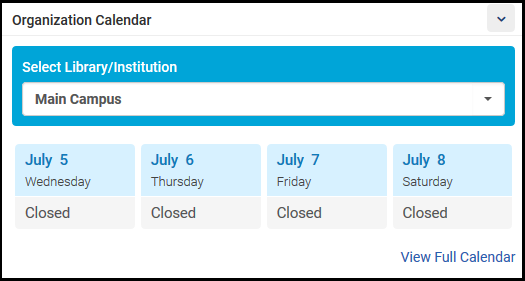 |
All | Information about institution and library hours and special events. A few days are shown in the widget; select View Full Calendar to open a pane with the full calendar. |
| Scheduled Jobs Status |  |
All | The status of scheduled jobs that ran in your institution, organized by type over the last five days. If there are any failed jobs, a red ! appears for that type on that date. Select the More Info link to view the Monitor Jobs page with those jobs pre-filtered to appear. See Viewing Completed Jobs. For more information about this widget, see Viewing Scheduled Job Summary Status. |
| Discovery Search |  |
All | For Primo VE environments only, this widget allows staff users to search for items using Rapido's search interface, which uses the default view defined on the View Configuration page. To configure this widget, see Configuring the Discovery Search Widget. |
| Administrator-created | 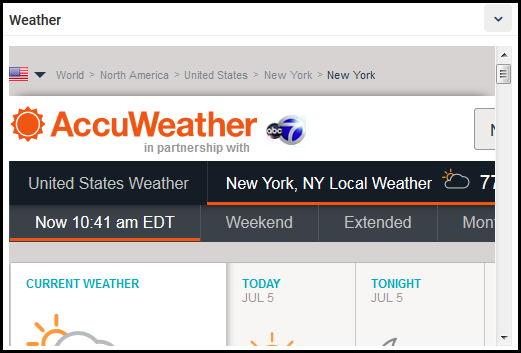 |
As defined by the widget | Administrators can create widgets linked to information on any website. For more information, see Configuring Widgets. |
The Navigation Bar
The main menu used to navigate in Rapido. Throughout this document, any reference to this menu uses a path of menu and sub-menu elements as follows: main section > sub-section > specific option, for example Fulfillment > Checkout/Checkin > Manage Patron Services. If the resulting page is also a menu of options, these options may appear in the documentation as additional elements to the path.
The Navigation bar can be collapsed to provide more room on the page while still remaining visible. It can be expanded again at any moment.
| Expanded State | Collapsed State | How to |
|---|---|---|
 |
 |
To collapse the Main Menu Navigation panel:
|
From the Navigation Bar you can easily search for specific menu option and set the menu options that you use frequently as Quick Links, so that the Rapido interface is personalized to your workflow and you don't have to go through the sub-menus every time.

- Fulfillment — Managing patron services, resource sharing with other libraries, and other patron requests.
- Admin — Administration activities, including managing users and jobs. Also, see the Configuration Menu in Configuring Rapido.
- Analytics — Creating, running, and viewing reports about Rapido usage. Some pre-packaged reports are available from this menu.
Select on the Navigation Menu and select an option from the My Homepage drop-down list. The options displayed here are configured on the Analytics Object List. For more information, see Displaying a Report Preview.
- Select
on the Navigation Menu or type Alt-Ctrl-F. Alternately, at the bottom of any menu area, select the search link.
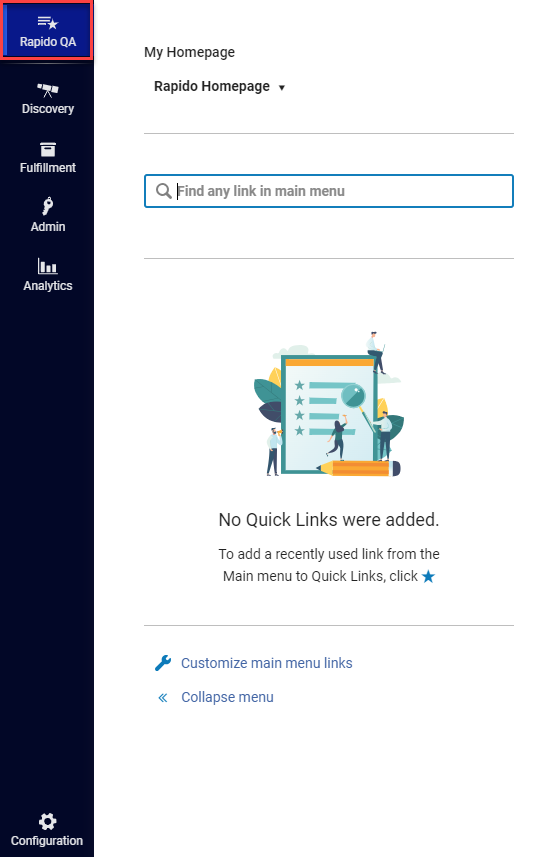 Search panel
Search panel - Enter your search term. Matching options in the Navigation Bar, as well as in the Configuration Menu, appear. Select the relevant option.
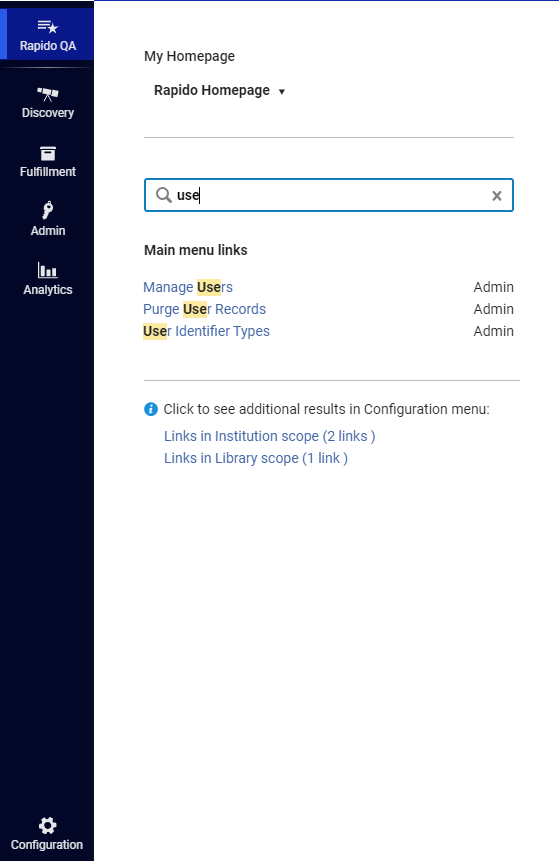 Matching search options
Matching search options
There are two methods to create Quick Links that you can use, depending on where in the Rapido menu you are:
|
From the Navigation Panel |
From the sub-menu |
|---|---|
|
|
Once created, you can do the following with the Quick Links:
- To view your Quick Links, select
to open the Quick Links panel, and select your link.
- Use the hotkey automatically designated to each Link to open the tools quicker.
- Select Pin Quick Links menu to pin all the Quick Links to you page, as additional menu below the Persistent search box, always available on all pages. To remove this menu, select Unpin Quick Links menu.
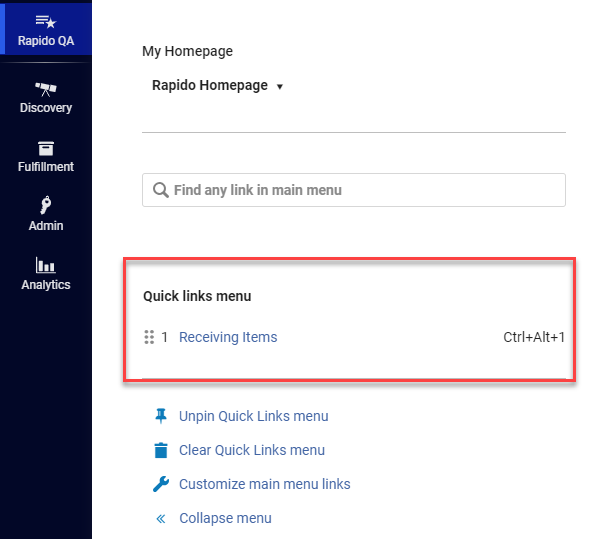
Do that if your screen is small and some of the links on the Navigation bar are located under the "..." button.
- In the Navigation bar, select the top option Rapido QA.
- In the panel that opens, select the Customize main menu links option.
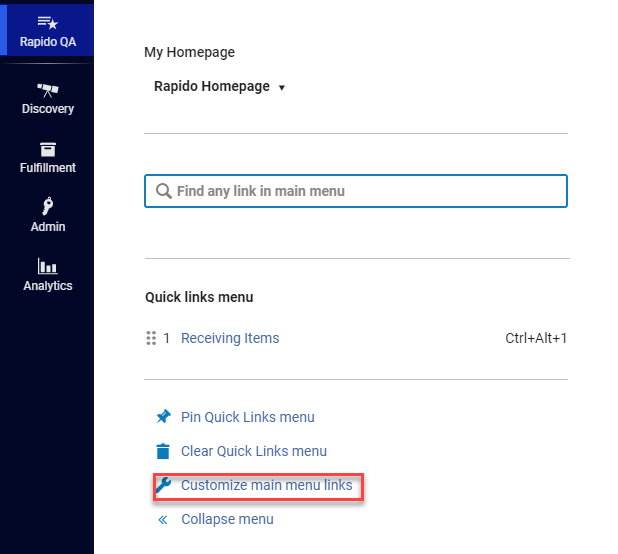
- In the Display Menu panel that opens, drag and drop the options that you do not need to the Hide Menu section below. This frees the real estate on the Navigation bar for the options that you do use. At any moment you can revert back or un-hide some of the options that you hid.
The Persistent Menu

- Logo – The logo of your consortia or institution. Select the logo on any page to return to the Rapido home page.
- Persistent Search Box
- Main Menu Icons – Icons include (from left to right):
Icon Description 
Library/desk selector (I am physically at:) – Rapido presents you with the features and options that are relevant to your user role and your logged in desk or department. You can switch locations using this menu: select the new location in the drop-down menu. The current location does not appear in the persistent menu by default. To display the current location in the persistent menu, select Always show current location in the library/desk selector menu. Library/Desk Selector Menu
Library/Desk Selector Menu
Current Location in Persistent MenuEnable Quick Printing – Select this option to set that all printouts that are created as part of a workflow via the user interface and going to a specific printer should print automatically, overriding the Print dialog. When using quick printing, the printing window immediately displays when the letter is generated. (not shown)
(not shown)RFID connection icon (appears only when an RFID integration profile is defined). 
User Menu – Your user name and photo (when available) appears as a link. Select the link to open the user menu. The options in this menu are as follows: - In some institutions, the first item in the menu is a language selector that you can use to change the language used in the UI. To change your language, select a new language from the drop-down list. The user interface changes to the selected language. Currencies and numbers in the UI and exported Excel files change to match the standard defined by the language (with commas, periods, and spaces in the appropriate locations). See Configuring Institution Languages.
- Change Password – Change your password. This option only appears for internally managed users (see Account Type). To change your password, enter your existing password and your new password twice and select Save. Your new password is saved.
 Change Password Dialog BoxDepending on your institution’s setup, you may be required to use passwords of a certain length, to include certain characters in your password, or to change your password at certain times.
Change Password Dialog BoxDepending on your institution’s setup, you may be required to use passwords of a certain length, to include certain characters in your password, or to change your password at certain times. - User Details – Display details about your user on the User Details page. For more information, see Editing Users.
- Detach from social account – If your user account has been associated with a social account and you want to disassociate the two, select this option to do so. This appears only if the user account is associated with a social account.
- UI preferences (on all pages other than the home page) – This submenu enables you to select the font size of the UI and whether the pages are presented with gutters (default) or full width. Select the font size (Display Density) to suit you. Your selection is saved between sessions. select the Shortcut Customizations link to view the global Rapido keyboard shortcuts and disable some of them, if needed. See Global Rapido Hot Keys.
- Feature Rollout Configuration – Open the Feature Rollout Configuration page, in which you can choose which optional new features to activate.
- Sign Out – Log out.

Help link – A menu of help options. Select from: - Browse Online Help – Open the Online Help.
- Help For This Page – Open the Online Help page that is relevant to the current UI page that you are on.
- What’s New Videos – View a page with links to the most recent video tutorials.
- Rapido Release Schedule – Display a pop-up with the last several, and next several, Rapido sandbox, production release, and release update dates.
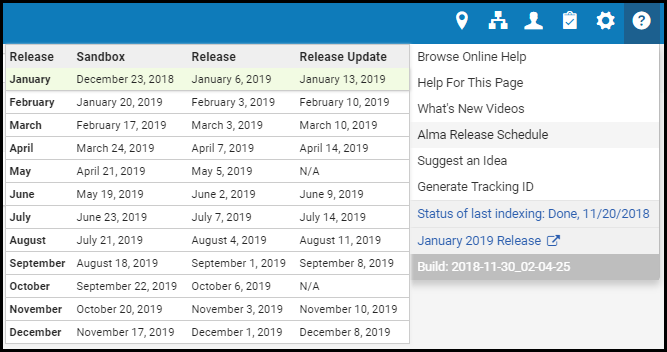 Release Dates Pop-up
Release Dates Pop-upThe current release version and build number appear at the bottom of the Help menu. For premium sandbox customers, when working in the sandbox, the build information indicates the date that this build was cloned from production. An asterisk in the Release Update column indicates the date of the next scheduled refresh.
- Suggest an Idea – Suggest an idea to Ex Libris. Select to open the Ex Libris Idea Exchange page in a new window.
 Ex Libris Idea Exchange
Ex Libris Idea Exchange - Generate Tracking ID – Generate a tracking ID for your Salesforce case to assist Ex Libris in debugging a problem. Use this when an error occurs but the error message does not contain a tracking ID. You should generate the ID as soon as possible after the error.
 Generate Tracking IDThe tracking ID is not enough to resolve your issue. You must still provide as many details of the problem as possible, such as the steps in the workflow that led to the error, which entities were involved (user identifier, item barcode, and so forth.), and any other information that might be relevant.
Generate Tracking IDThe tracking ID is not enough to resolve your issue. You must still provide as many details of the problem as possible, such as the steps in the workflow that led to the error, which entities were involved (user identifier, item barcode, and so forth.), and any other information that might be relevant.Watch the Tracking ID Generator video
- Generate Performance Tracking File – Generate a performance tracking file if Rapido displays performance issues, such as long search times. Open a support issue and attach the file to the issue. The information in the file can help the support team resolve the issue. For frequently asked questions about Performance Tracking files, see here.
Generate the tracking file immediately after experiencing the performance issue, before doing any other action.
- Instance Name - Displays the name of the environment currently in use.
- Instance Location - Displays the location of the data center for this instance.
- Status of Last Indexing - The date of the last indexing appears, which could be either the status of the last semi-annual indexing or the status of any indexing process initiated by the system or by customer support. The semi-annual reindexing is full reindexing of the Rapido repository, done twice a year (generally in July and December; for a more detailed explanation see here). While semi-annual indexing runs, it appears under Running Jobs tab (Admin > Monitor Jobs). If you want to run a full reindexing at other points in time, contact Ex Libris Support. If you are a Depositing Administrator, General System Administrator, or Repository Administrator, the date that appears here is a link. Select the link to view the indexing job report.
- A link to the most recent Rapido release notes.
- In your sandbox environment, the date of the last clone from production.
My Activity Center pane - allows you to view and access your recent activity, including the Recent Entities list that lists all the entities you have added, updated, and deleted within the last 7 days. You can scroll through the list and select an entity to resume your work, or you can view the entity in view-only mode. The Recent Entities list is a helpful way to find the records you have recently accessed, even if you do not remember their names. It also allows you to easily view your recent changes to your records. At any moment you can open and close the Recent Entities list, and then resume your ongoing work without interrupting its context.

Rapido Announcements pane - enables Ex Libris to update users on important issues, unusual occurrences, or major feature rollouts, as well as provide ad-hoc updates and announcements.
Page Header and Summary Panel

- A back icon
 , if this page was opened from a list or as part of a larger procedure.
, if this page was opened from a list or as part of a larger procedure. - The page title.
- Any relevant actions (as buttons) to perform page-level actions on the page.
- The default action (typically Save) is highlighted in blue.
- If there are too many actions to display, additional actions are available in the or ... menu to the right of the displayed actions.
Configuring Rapido
- Select the
 icon. The following changes take place:
icon. The following changes take place:
- The Rapido Main Menu changes to the Rapido Configuration Menu. To distinguish it from the Rapido menu, the bar color changes to the default primary color in the user interface, and its icons feature a cog wheel to distinguish them from the regular Rapido icons.
- The persistent search bar disappears, and the dropdown of units to configure appears instead.
- Instead of the main Rapido window, a dedicated screen opens.
- In the top dropdown, select the unit to configure.
- Select the functional area to configure, such as Acquisitions, and find the specific configuration tool you need.
- To close Rapido Configuration and to return to the task you left in Rapido, select the
icon.

Global Rapido Hot Keys

Copy Option When Selecting Text
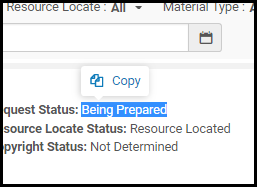
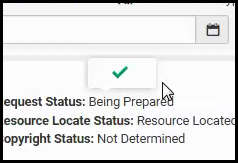
Icons
Info Icon
User Information Icon
 beside a user name on various pages and pop-up windows, such as the User Details page.
beside a user name on various pages and pop-up windows, such as the User Details page.![]()

Translate Information Icon
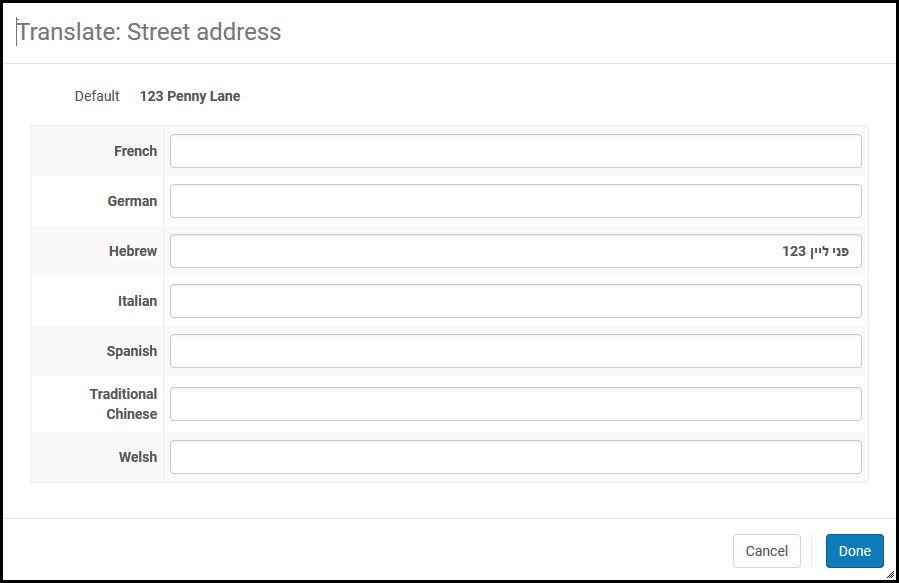
Messages
Rapido returns messages on many pages based on your actions or missing or required information. Messages appear in a notification bar on the side of the page. The notification bar displays message types of Information, Error, and Success, each with different icons and colors. In confirmation dialog boxes and other smaller panes, the messages appear on the page (not floating). If you ignore a message but continue to work on the page, the message is minimized to its icon and remains on the page.
- Success – An action you performed succeeded. In the case of an action that initiates a job, success only means that the job was submitted successfully, not that the results of the job were successful. After successfully submitting a job, you can select the job number in the message to open the Manage Jobs page (see Viewing Running Jobs).
Select X to remove the message or > to minimize the message. When enabled by Ex Libris, you can select Collapse by default to make all success messages on this page appear initially collapsed.
 Success Message
Success Message - Error – Your action could not be performed, or it failed. The message indicates the reason for failure, when available (see also Generate Tracking ID in The Persistent Menu). Select > to minimize the message.
 Error Message
Error Message - Information – An indication of a normal event about which you should take notice. Select X to remove the message.
 Information Message
Information Message
Tabs
"Has Content" Indication

Common Rapido Tabs
Notes Tab
Managing Notes in the Notes Tab


Active and Inactive Notes
In Resource Sharing task lists (Borrowing Requests and Lending Requests), the notes can either be active or inactive. Active notes are notes that require processing, while inactive notes add information to a request, but do not call for any action to be performed. These are settings that are applied to all of the notes attached to a task. That is, the notes are either active or not, as a group. When the notes attached to a task are active, a Notes link appears in the task's row in the task list. select the link to open the Notes section of the task in the Details pane. When the notes are not active, no Notes link appears in the task's row, but you can still see and manage any notes that are attached to the task in the Notes section of the Details pane.

By default, the notes attached to a task are inactive. Adding or deleting notes does not affect this setting. When at least one note is attached to a Resource Sharing task, an Update Notes menu is added to the Notes tab of the task.
- In the task list, in the task's row - or in the Details pane when the task is selected - select Edit. The full form of the task opens in a sliding panel.
- In the Notes tab, in the Update Notes menu, select one of the following:
- Activate Notes to activate the notes
- Dismiss Notes to deactivate the notes

A confirmation message appears.
- Close the sliding panel.
- Select
 to refresh the task list. The Notes link is added to or removed from the task's row, depending on the option you chose.
to refresh the task list. The Notes link is added to or removed from the task's row, depending on the option you chose.
Attachments Tab

- To add an attachment, select Add Attachment. Browse for a file, add a URL and/or note, if required, and select Add Attachment.
- To edit an attachment, select Edit in the row actions menu.
- To delete an attachment, select Delete in the row actions menu and select Confirm in the confirmation dialog box.
- To download a file, select Download in the row actions menu, browse to the download folder, and select OK.
The maximum attachment size is 25 MB. Emails sent to a user or regarding a PO line page appear in this tab.
History Tab


- The History tab of the Monitoring Jobs page has a different functionality. For more information, see Viewing Running Jobs.
Drop-Down and Quick Pick Lists
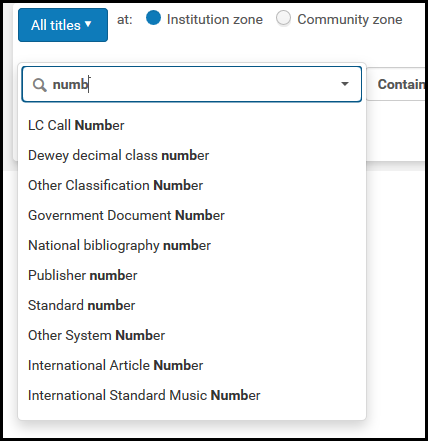

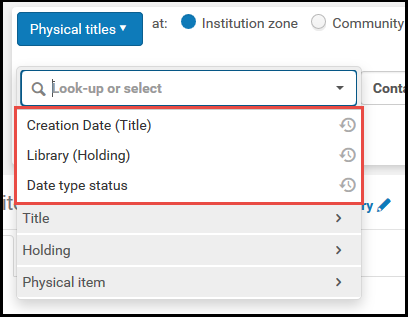

Lists and Tables in Rapido
Common Table/List Types
Record Lists


- A table actions list, if any. See List, Table, and Row Actions.
- The second to last link
 is an option to export the displayed elements in the table to Excel (see Export to Excel).
is an option to export the displayed elements in the table to Excel (see Export to Excel). - The last link
 enables you to customize how the results appear in the list; see below.
enables you to customize how the results appear in the list; see below.
- The second to last link
- Pagination options, when required (see Pagination)
- Facets for filtering the items on the list (see Facets, Filters, and Secondary Search)
- Its number in the list
- A checkbox, if there is a page-level action that can be performed on multiple items in the list
- The item's name, typically linked to a page where you can view more information about the item
- Various other information fields about the item
- A row actions list that enables you to perform actions on the item. See List, Table, and Row Actions
- If you are returning to this page after having viewed or edited an item in the list, that item is highlighted (see Last Item Edited Indicator).
- On some pages, additional information appears in tabs at the bottom of each list item. For example:
- Inventory in search results may appear. Select one of the tabs to expand or collapse this information. If an Expand table action is present, you can use it to pre-select that all tabs, or all tabs of a certain type, are expanded by default.
Record List Fields with Multiple Values
 ). Select the multiple values icon to display all the values for the field.
). Select the multiple values icon to display all the values for the field.

Record List from Single Record Search
Configure Record List Appearance

- For an entry in the list, if the entry does not contain a value for a field, the field does not appear.
- Currently, when configuring the available row actions on a page, the list of row actions displays all actions that can be performed on the kinds of entries that populate the list, even if these actions do not appear on the page (this is most noticeable on pages where the entries are PO lines). Regardless of the row actions that you select to appear while configuring, if the action is not relevant for the page or the entry, it does not appear in the row actions.
List Tables

- A table actions list, if any. See List, Table, and Row Actions.
- The second to last link
 is an option to export the displayed elements in the table to Excel (see Export to Excel).
is an option to export the displayed elements in the table to Excel (see Export to Excel). - The last link
 enables you to customize the columns that appear. Select or deselect columns to appear in the table, and then select Done. For more information, see Working with Table Columns.
enables you to customize the columns that appear. Select or deselect columns to appear in the table, and then select Done. For more information, see Working with Table Columns.
- The second to last link
- In some cases, you may have options to sort the list. You may be able to move an item down or up the list by selecting the up or down arrows in the Move Up and Move Down columns. Or you may be able to drag and drop items by selecting and dragging the drag and drop icon
 . The selected row is highlighted, and, as you drag the row up and down the table, a blank bar appears below or above other rows, indicating to where the selected item is dropped.
. The selected row is highlighted, and, as you drag the row up and down the table, a blank bar appears below or above other rows, indicating to where the selected item is dropped. - Pagination options, when required (see Pagination)
- Facets for filtering the items on the list (see Facets, Filters, and Secondary Search)
- Its number in the list
- Various information fields about the item
- A row actions list that enables you to perform actions on the item. See List, Table, and Row Actions.
- If you are returning to this page after having viewed or edited an item in the list, that item is highlighted (see Last Item Edited Indicator).
Code Tables

- The page title Code Table
- A summary header with basic information about the table
- A table actions list, if any. See List, Table, and Row Actions.
- The first option enables you to import information to the table (see Importing Code Table Information).
- Another option enables translation for multi-language institutions (see Code Table Label Translation).
- Add Row enables you to add a new row, when available (see Adding Lines to Tables).
- The last link
 is an option to export the displayed elements in the table to Excel (see Export to Excel).
is an option to export the displayed elements in the table to Excel (see Export to Excel).
- The option to Cancel your changes or Save / Customize to save your changes.
- Its number in the list
- The option to enable/disable the element by toggling a slider; a blue slider
 indicates that the element is enabled; a gray slider
indicates that the element is enabled; a gray slider  indicates that the element is disabled. These sliders are not functional on all code tables. If the slider colors are muted (
indicates that the element is disabled. These sliders are not functional on all code tables. If the slider colors are muted ( /
/  ), you must first enable the line using the Customize row action before you can change their values.
), you must first enable the line using the Customize row action before you can change their values. - The options to move an item down or up the list by selecting the up or down arrows in the Move Up and Move Down columns
- The code and description of the item. These can often be changed, either directly or after selecting Customize in the item's row actions list. Select Save after making any changes to the table.
- The option to select one of the items as the default value. Only one value can be selected. For some tables, this value may be disabled or may have no relevance.
- The user who last changed the element and the date of the last change
- A row actions list, typically containing at least the option Customize if you have not yet customized the list, or Restore if you have. Select Restore resets the row to its original value. After selecting a row action, select Save at the top of the page to save your changes. When available, select Delete to remove the row.
Mapping Tables

- Page Titles: Page titles are incorporated as headers for mapping tables, providing clearer context and easier identification of mapping table content.
- A summary header with basic information about the table.
- Inner Search: An inner search functionality enables searches within the mapping table context to quickly locate specific entries.
- Responsive Columns: Users can expand/reduce the width of the columns and change the columns' order (using drag and drop).
- Responsive Columns with Text: Mapping table columns display text instead of fields.
- Pagination: The pagination feature enables users to effectively manage large mapping tables. Users can navigate through mapping table entries using page numbers.
- A table actions list, if any. See List, Table, and Row Actions.
- Add Row enables you to add a new row, when available (see Adding Lines to Tables).
- The last link
 is an option to export the displayed elements in the table to Excel (see Export to Excel).
is an option to export the displayed elements in the table to Excel (see Export to Excel).
- The option to Cancel your changes or Save to save your changes
- Its number in the list
- The option to enable/disable the element by toggling a slider; a blue slider
 indicates that the element is enabled; a gray slider
indicates that the element is enabled; a gray slider  indicates that the element is disabled. These sliders are not functional on all mapping tables. If the slider colors are muted (
indicates that the element is disabled. These sliders are not functional on all mapping tables. If the slider colors are muted ( /
/  ), you must first enable the line using the Customize row action before you can change their values.
), you must first enable the line using the Customize row action before you can change their values. - The key (code) and other information for the item. These values, other than the key, can often be changed, either directly or after selecting Customize in the item's row actions list. Select Save after making any changes to the table.
- The user who last changed the element and the date of the last change
- A row actions list, typically containing at least the option Customize if you have not yet customized the list, or Restore if you have. Select Restore resets the row to its original value. After selecting a row action, select Save at the top of the page to save your changes. When available, select Delete to remove the row.
Rules Tables

- Each rule has one or more criteria for Rapido to check to see if the rule applies to the current object being evaluated.
- When the relevant process occurs in Rapido, for example, a request, Rapido checks each enabled rule in the relevant rules table, in the order in which they are listed, starting with the first rule in the list. If Rapido finds a rule whose criteria matches the object being evaluated, Rapido performs the action specified by the rule. Once Rapido finds a match, Rapido does not check any other rule in the list.
- If none of the enabled rules match the object being evaluated, the default rule is checked, if such exist.
- If none of the enabled rules match the object being evaluated, and the default rule also does not apply (or if there is no default rule), Rapido performs the default action. Typically this is "do nothing", but a different default action may apply for a particular process. In some cases, the default action can be specified using a customer parameter.
- See the relevant documentation pages for details or exceptions to the above.
- Add a rule: Select Add Rule in the table actions list. The new rule is added to the end of the list. By default, each new rule is enabled.
- Edit a rule: Select Edit in the row actions list.
- Duplicate a rule: Select Duplicate in the row actions list. Edit the rule as required. The new rule is added to the end of the list. By default, each new rule is enabled.
- Delete a rule: Select Delete in the row actions list.
- Enable/disable the rule: Toggle the slider. A blue slider
 indicates that the rule is enabled; a gray slider
indicates that the rule is enabled; a gray slider  indicates that the rule is disabled.
indicates that the rule is disabled. - Change the rule order: Select the up or down arrows in the Move Up and Move Down columns for the rule that you want to move up or down in the list.

- Each rule requires a name. You can also enter an optional description.
- In the Input Parameters area, you can enter multiple criteria for the rule. On most pages, select Add Parameter to add criteria (in Acquisitions pages, all aspects are already present on the page in their own row). You can edit or delete criteria.
- Each criteria consists of three elements:
- Name - The aspect you want to evaluate (such as the user group of the user who scanned a book or the date a request was made).
- Operator - An evaluation operator, such as =, <, >, Not equals, inList, NotinList, is empty, is not empty, or contains.
- Value - The matching value or values (for inList and NotInList, select all that apply).
- Each input parameter (Name) can only be selected once for each rule.
- In the Output Parameters area, (on some pages this area is called Workflow Setup), enter or select the action to perform, as described on the relevant documentation page. The value may simply be True or False, indicating whether or not Rapido performs a certain process. Or there may be several values to enter or select.
- After making any changes, select Save.
List, Table, and Row Actions

 , with options to export all or some of the list to a Microsoft Excel file. See Export to Excel. Another common table action above a table is Add Row; see Adding Lines to Table. Code tables allow you to add lines in bulk; see Importing Code Table Information.
, with options to export all or some of the list to a Microsoft Excel file. See Export to Excel. Another common table action above a table is Add Row; see Adding Lines to Table. Code tables allow you to add lines in bulk; see Importing Code Table Information.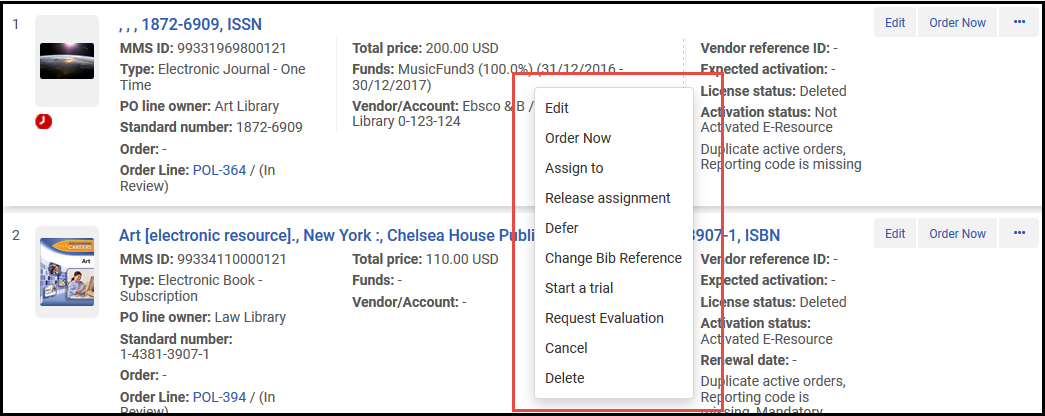
Adding Lines to Tables


Importing Code and Mapping Table Information

- The Excel sheet must be named CodeTable
- The columns must be named Code and Description (case-sensitive) to match to the target, so after exporting a code table, rename the columns to these values.
- For tables in which lines cannot be added/removed manually, lines also cannot be added/removed via the import process.
- The Excel sheet must be in a specific structure. It is recommended that you export the existing table to get the existing values and the structure (if relevant), make your changes, and then import the changes back to Rapido, as described below.
- Export the file using Export > Excel (see Export to Excel).
- Open the Excel file and rename the Excel sheet CodeTable.
- Make your changes and save the file. Note that there should be no duplicate lines in the Excel file.
- Select Import on the relevant page. The Import Tables page appears.
- Select Browse to locate your file.
- Select Import to upload the file. The contents of the file appear on the page.
- Review your changes and select Import to import the changes to Rapido.
- The process as is for code tables, but without the need to change or rename the file.
The structure of the Excel file includes the actual codes that are imported back into Rapido, in addition to columns of descriptions that help you make sense of the data, but are not imported. The description values can be duplicated. In addition, the Excel file includes additional sheets, which are also not imported back into Rapido, that provide you with full lists of codes and values that can be inserted into the Rapido dropdowns - you can use these sheets when adding new rows to the Excel file, instead of referring to Rapido for these code/value combinations.
There cannot be duplicate lines in the codes that are imported back into Rapido.
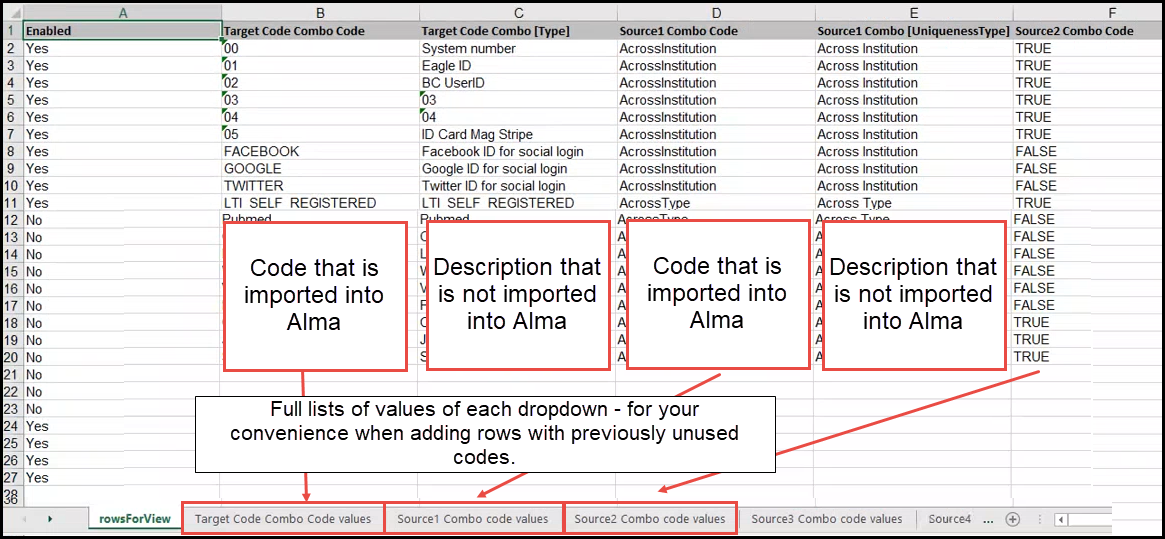
Export to Excel
 and selecting Excel. When exporting a table with hidden columns, you can choose to export only the visible columns or all of the columns, including the hidden ones.
and selecting Excel. When exporting a table with hidden columns, you can choose to export only the visible columns or all of the columns, including the hidden ones.
Values exported to the Excel sheet may not be accurate, depending on the list or table.
Table and Row Level Customization Mode


Code Table Label Translation
- Change the language filter to a language other than English.
- Edit the text in the Translation column.
You need to update the column header of the Translation column to be the language name.
- Select Save.
 Table Level Customization
Table Level Customization
- Change the language filter to a language other than English.
- Select Customize in the row actions list to customize a row, or select Customize All in the table actions list to make all of the rows of the table available for customizing.
- Edit the text in the Translation column.
You need to update the column header of the Translation column to be the language name.
- Select Save.
 Row Level Customization
Row Level Customization
Facets, Filters, and Secondary Search
Facets and Filters

| Collapsed State | Viewing Facets in Collapsed State | To Restore |
|---|---|---|
|
Minimize the Facets pane by selecting << beside the word Facets. The panel collapses into a small stripe on the left of the screen.
|
You can view the facets by hovering your mouse over the Facets stripe.
|
Select >> to restore the Facets pane. |
Secondary Search

Pagination

- Select one of the arrows < or > (or press Alt-, or Alt-.) to display the previous or next page.
- Select a page number to display that page.
- Enter a page number in the small text box and select Go to display that page.
- You can select the number of lines per page. On some pages, the range is between 10 and 50. On other pages it is between 20 and 100.
 Results Per Page Tool
Results Per Page Tool
- Rapido does not preserve selections that you make as you navigate from page to page (exception: Rapido remembers your selection for results per page). All actions on the page apply only to the visible selections you make on that page.
- If the bottom pagination is not visible, a small floating version of the pagination element appears at the bottom of the page. To navigate to a specific page when the floating pagination is visible, select the page number, enter a new page number, and press Enter.
Last Item Edited Indicator

Working with Table Columns
- For columns that have up/down triangles, you can sort the rows in the table by that column by selecting the column heading. Select the column heading again to toggle between ascending and descending order.
Sorting a table changes the order of the lines in the table, and your selected sort is retained when you leave and return to the page. However, the sort has no effect on how items in the table appear in other areas of Rapido. For example, if you sort users in descending alphabetical order (Z to A) on the Find and Manage Users page, the relevant list of users still appears in ascending alphabetical order (A to Z) when selecting to assign a task to a user.
- Select between two column headings to change the width of table columns.
- Select and drag a column heading left or right to change the order of table columns.
- Hide and display columns by selecting
 in the table actions list. To configure record list columns, see Record Lists.
in the table actions list. To configure record list columns, see Record Lists.
 Hide/Display Columns Pane
Hide/Display Columns Pane- Clear the checkbox of a column and select Done to hide the column.
- Select the checkbox of a hidden column and select Done to have it appear.
- Select Restore list defaults to restore all columns to their original settings.
If you have previously customized the columns on this page, the icon has a small green dot in the lower right corner . When you select the icon, the option to Restore list defaults appears. Select to restore the columns to their out-of-the-box settings.
. When you select the icon, the option to Restore list defaults appears. Select to restore the columns to their out-of-the-box settings. - Select the row list action View Hidden to display a pop-up of any hidden fields for that row. For example:
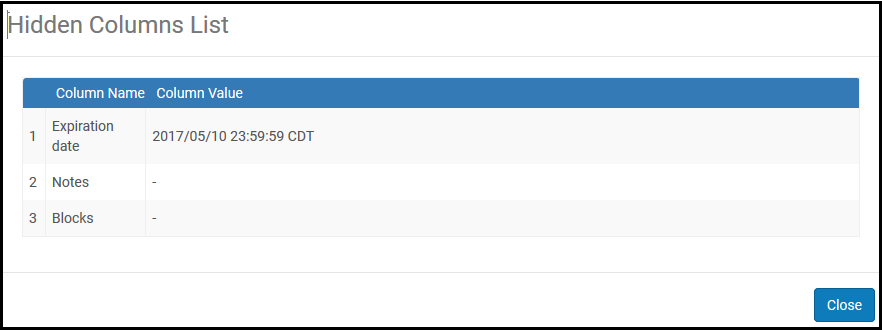
Hidden Columns List


